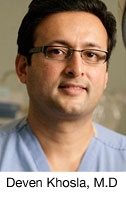Scoliosis is an abnormal curvature of the spine (from side to side when looking at a person from the back) measuring 10 degrees or more. While we often associate scoliosis with children, it is even more prevalent in aging adults–20% in adults versus 3% in adolescents.1 In fact, rates of scoliosis in those over 60 years of age was documented in one well-regarded study at 68%.2
What causes scoliosis?
There are three distinct types of adult scoliosis, but the most common by far is degenerative scoliosis caused by degeneration of the spinal discs. All adults have some level of degenerative disc disease simply from the natural aging process of their discs and the effects of gravity. A much smaller number will have debilitating or painful results from this degeneration and a subset of that group will develop scoliosis.
Disc degeneration occurs most frequently in the lower back (lumbar spine) in those over 65. This is often accompanied by stenosis (a narrowing of the spinal canal) leading to pinched nerves and associated pain, tingling and weakness in the extremities. Other types of scoliosis include idiopathic scoliosis (no know cause), congenital scoliosis (caused by a birth defect), post-traumatic scoliosis (occurring as a result of fractures of the spine), and neuro-muscular scoliosis (generally seen in patients with polio, muscular dystrophies, or other neuromuscular disorders).
Common characteristics of adult scoliosis
Adult scoliosis patients tend to get diagnosed when they see a physician complaining of back pain or other neurological deficits resulting from pinched nerves. They may have any number of the following symptoms:
- Back pain
- Numbness, tingling, or extremity weakness resulting from pinched nerves from herniated discs and associated arthritis
- Low bone density
- Uneven shoulders
- Head is not directly centered above the pelvis
- One or both hips are raised or unusually high
- Rib cages are at different heights
- Uneven waist
Diagnosing Adult Scoliosis
Along with a physical examination, the main diagnostic tool for scoliosis is an x-ray with the patient standing and the spine under load. MRI’s, where the patient is lying down, typically miss the detection of scoliosis although they can be useful for detecting tumors, fractures and spinal stenosis.
Other tests may also be performed including CT scans (to look at bony detail), CT myelography (to look at nerves in different positions), nerve root blocks, facet blocks, discography and DEXA scans.
Treating Scoliosis
The goal of treatment is to both limit the progression of scoliosis and decrease pain and discomfort.
Non-Operative Treatment
The majority of treatment options for adult scoliosis are non-surgical. Degenerative scoliosis is progressive with curvature increasing up to 1.64 degrees over a year and considerably faster in women following menopause.3 While scoliosis can not be prevented, it’s progression can be slowed or even stopped through exercise, physical therapy, dietary considerations and conscientious movement.
Exercise
Having strong, stable back muscles helps support the spinal column and hold it in alignment. Exercise can both help maintain function and control back pain. Recommended are SEAS exercises (Scientific Exercises Approach to Scoliosis exercises) that have been developed specifically to recover postural collapse, postural control and vertebral stability. Studies have shown that patients can actually reverse spine deformity through regular, specific exercise.4 Effective exercises include back extensions, seated rows, leg and arm extensions.
Body Posture
Avoid activities that require overexertion on only one side of the body such as carrying backpacks and heavy bags on one shoulder, or one-armed repetitive sports like baseball pitching. While slumping won’t give you scoliosis, focusing on sitting and waking straight, and keeping shoulders back.
Dietary Enhancements
Many of those with degenerative scoliosis also have osteoporosis and/or low bone density. Vitamin D and calcium supplementation for patients with low bone density is recommended.
Injections
Spinal injections may help to alleviate leg pain occurring as a result of pinched nerves in the lumbar spine and may also serve as a diagnostic tool helping to locate the source of pain.
Operative Treatment
There are some cases where surgery to correct scoliosis is warranted. The goals of most surgical procedures for adult scoliosis are to straighten the spine as much as possible, stop the progression, remove any pressure from the nerves and
Characteristics of cases that may indicate a surgical approach include:
- Progressive curvature measuring 40° or more
- Pain unresponsive to non-surgical treatments
- Significant pain, weakness, and numbness in extremities
- Significant stenosis (degeneration of spinal column)
- Significant deformity
In most surgical cases, a discectomy is often performed first (removal of a spinal disc), followed by insertion of long rods into the spine and a bone graft added to encourage spinal fusion.
To some extent, we all will experience scoliosis as we age, but for those with pain and mobility impairment caused by incorrect curvature, a visit to a spine expert could significantly improve your quality of life.
[hr toptext=”” size=”” custom_size=”5″ hide_mobile_hr=”true”]
1. Adult Lumbar Scoliosis: Underreported on Lumbar MR Scans. Z. Anwara, E. Zana, S.K. Gujara, D.M. Sciubbaa, L.H. Riley IIIa, Z.L. Gokaslana and D.M. Yousema, doi: 10.3174/ajnr.A1962 AJNR 2010 31: 832-837
2. Schwab F, Dubey A, Pagala M, et al. “Adult scoliosis: a health assessment analysis by SF-36.” Spine 2003;28:602-6.
3. Natural history of progressive adult scoliosis. Marty-Poumarat C, Scattin L, Marpeau M, Garreau de Loubresse C, Aegerter P. Spine 2007 May 15;32(11):1227-34; discussion 1235.
4. Adult scoliosis can be reduced through specific SEAS exercises: a case report. A. Negrini, S. Parzini, M.G. Negrini, M. Romano, S. Atanasio, F. Zaina, and S. Negrini. Scoliosis 2008, 3:20.
[hr toptext=”” size=”” custom_size=”20″ hide_mobile_hr=”true”]

